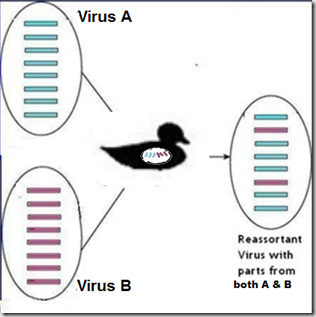[Source: The Lancet, full free access page: (LINK). Extract.]
The Lancet, Early Online Publication, 26 February 2014
doi:10.1016/S0140-6736(14)60386-X
Copyright ? 2014 Elsevier Ltd All rights reserved.
Poultry carrying H9N2 act as incubators for novel human avian influenza viruses
Original Text
Di Liu a, Weifeng Shi b, George F Gao a c
_____
After being hit by avian influenza A H7N9 virus (134 individuals infected and 45 deaths in 2013, and 213 cases and 66 deaths as of Feb 23, 2014), China had their first case of fatal H10N8 infection in a human being on Dec 17, 2013, in the Jiangxi Province, which has been followed by two more cases in the same province.
The two novel influenza viruses that affect human beings, H7N9 and H10N8, have similar genetic lineage: the haemagglutinin (H) gene originated from ducks and the neuraminidase (N) gene from wild birds.
(?)
We declare that we have no competing interests.
_____
a Institute of Microbiology, Chinese Academy of Sciences, Beijing, China; b Taishan Medical College, Shandong, China; c Chinese Center for Disease Control and Prevention, Beijing, China
-
-------
The Lancet, Early Online Publication, 26 February 2014
doi:10.1016/S0140-6736(14)60386-X
Copyright ? 2014 Elsevier Ltd All rights reserved.
Poultry carrying H9N2 act as incubators for novel human avian influenza viruses
Original Text
Di Liu a, Weifeng Shi b, George F Gao a c
_____
After being hit by avian influenza A H7N9 virus (134 individuals infected and 45 deaths in 2013, and 213 cases and 66 deaths as of Feb 23, 2014), China had their first case of fatal H10N8 infection in a human being on Dec 17, 2013, in the Jiangxi Province, which has been followed by two more cases in the same province.
The two novel influenza viruses that affect human beings, H7N9 and H10N8, have similar genetic lineage: the haemagglutinin (H) gene originated from ducks and the neuraminidase (N) gene from wild birds.
(?)
We call for either a shutdown of live poultry markets or periodic thorough disinfections of these markets in China and any other regions with live poultry markets.
We declare that we have no competing interests.
_____
a Institute of Microbiology, Chinese Academy of Sciences, Beijing, China; b Taishan Medical College, Shandong, China; c Chinese Center for Disease Control and Prevention, Beijing, China
-
-------


Comment